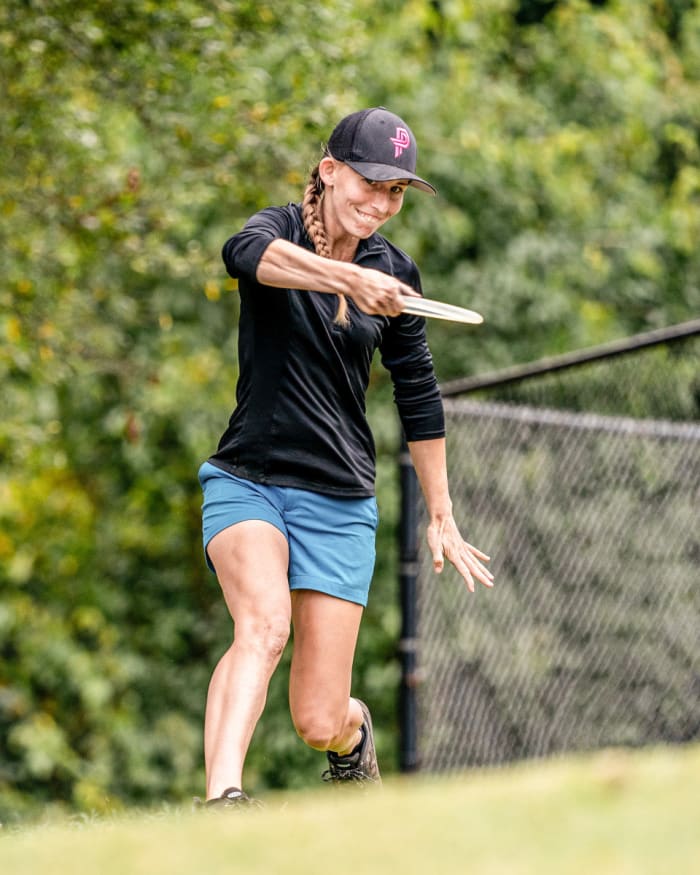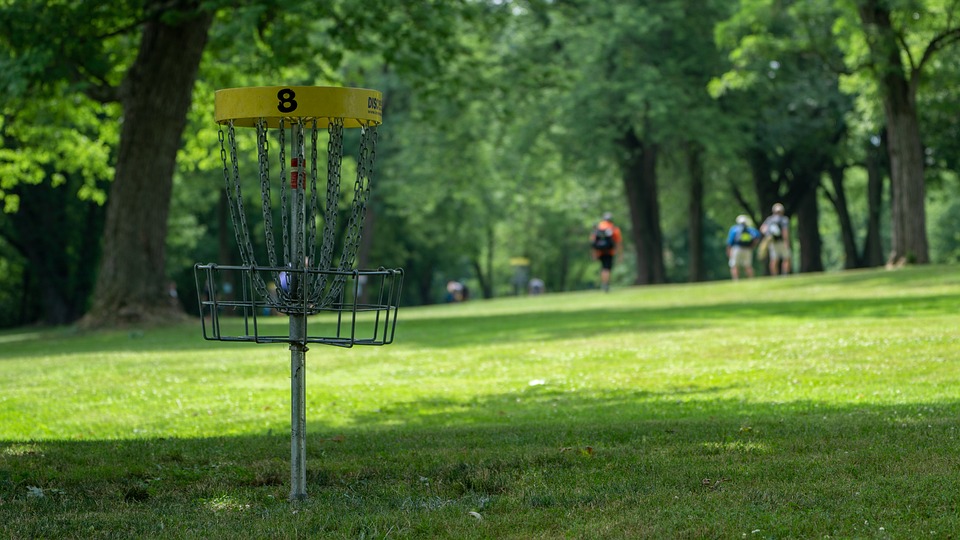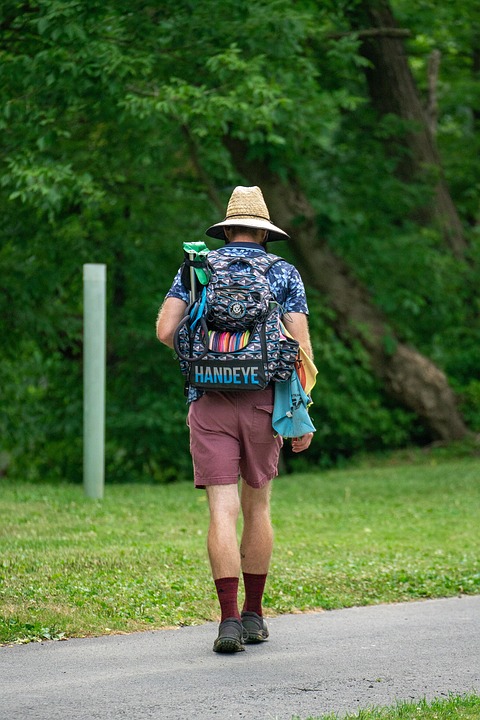Disc golf is the rare sport that’s thrived during the pandemic
In the early 1990s, Wayne Pierce would play disc golf with his friends on the weekends in Plano, Texas, while pushing his infant daughter, Paige, around in a stroller. Once Paige grew old enough, she started throwing alongside them, with her dad dangling ice cream rewards if she made par.
As Wayne improved, eventually placing second in the amateur division of the 2002 PDGA Disc Golf World Championships, so did Paige. By age 12, she was outdriving the grown men she’d grown up learning the sport from.
“You’d always hear about the 12-year-old girl out-throwing the dudes,” recalls Eric McCabe, the 2010 men’s world champion who became a family friend after competing with Pierce’s father. “She had better form than any other person—not just lady, but any other person in the sport.”
“That really got me hooked,” Pierce said. “I realized it’s not just my dad showing me support because he loves me; I’m actually pretty good at this. These claps and cheers are genuine and not just some show of support for a young girl.”
Wayne, who works as a plumber, registered her for disc golf tournaments all over Texas during the summer, when school was out and her favored sport, soccer, was out of season. He ended up selling his own collection of discs to help pay for travel costs.
“It was sort of like she was living my dream,” Wayne said. “I wanted her to be able to take advantage of her youth and say that it worked. Because she had it from the beginning … I always believed I could make her into something that even she didn’t know she could be.”
Pierce has done far more than live out her father’s dream. She’s raised the bar for disc golf competitively and financially while helping out the women who may eventually knock her off her perch. Just don’t bet on that happening anytime soon. Pierce boasts the driving distance (upwards of 500 feet) to thrive on wide-open courses, the technical ability to win in wooded environments and the accuracy to sink putts from seemingly impossible lengths. The Texan with a warm smile, aw-shucks aura and lean 5′ 5″ frame may be the most dominant athlete at any level of any type of golf—ball, disc, you name it—or perhaps even any individual sport.
As the COVID-19 shutdown forced the world to socially distance and avoid indoor gatherings, most sports were put on hold. But disc golf—played outdoors and socially distanced even in normal times—experienced unprecedented growth. Professional events were broadcast on CBS Sports and ESPN2 for the first time, filling programming vacuums left by the abrupt stoppage of nearly every sports league of note.
And though disc golf probably won’t be the only sport on the airwaves again anytime soon, its days toiling in obscurity are over. Disc golf is here to stay.

Credit: Photo Illustration by Dan Larkin; Nathaniel S. Butler/NBAE/Getty Images (James); Gaelle Beller Studio/Getty Images (Mask)
Read More Stories On the Year of the Shutdown
The first recorded instance of golf being played with flying discs occurred in 1926, when a group of Canadian kids fashioned the game of “Tin Lid Golf” around the grounds of their elementary school. But the modern movement that led to disc golf’s legitimization as a sport started in the early 1960s in various U.S. locations including the tree-lined campus of Rice University, the streets of Newport Beach, Calif., and Pendleton King Park in Augusta, Ga. Early players would target water fountains, trash cans or whatever else was deemed suitable.
The first specialized disc golf course was designed and installed in 1975 in Pasadena, Calif., by Ed Headrick, who also invented the Frisbee and the prototype for the modern disc golf “hole”—the Disc Pole Hole catching device, which consists of 10 chains hanging in a parabolic shape over an upward opening basket. Players must land discs—which are smaller, faster and more aerodynamic than Frisbees—in the basket to complete a hole. Headrick was motivated to create a standardized target in part to stifle arguments among his friends over whether someone actually had hit one of the objects in their makeshift courses.
The following year, Headrick formed the Disc Golf Association (DGA)—a company to build equipment for the sport—and later the Professional Disc Golf Association (PDGA), a not-for-profit that oversees the sport’s top-level competitions and generates the majority of its revenue from annual membership fees ($50 for amateurs, $75 for professionals) and event sanctioning.
For decades, disc golf was mostly regarded as a hobby for college kids and stoners working their way through a six-pack as they played. It has matured over time; however, and especially experienced incredible growth in 2020—likely partially due to its ability to be played outdoors and socially distanced. But it was also the continuation of a growth trend that occurred through the 2010s.
Nearly 50 years after the PDGA’s humble beginnings, it now boasts 150,000 members, with 70,000 of those retaining active status for tournaments—a figure that’s doubled since 2016 and is roughly an 80/20 split of amateurs to professionals. Last year alone saw the registration of more than 20,000 members, continuing a 13-year streak of record membership growth.
These numbers don’t account for casual players, who surely outnumber PDGA members and have far more courses to play on than there were just a few years ago. As of November 2020, there were 11,300 courses in the world. That’s a 66% increase from the last count performed in May 2017, when there were 6,800. Roughly 8,000 of those are in the U.S., with Finland, Canada and Sweden coming next on the list of 71 countries that host courses, which are often woven into community parks or even share space with ball golf. An average of 3.5 courses were built each day in 2020, and 70% of courses have been built in the last 10 years, according to a study published by UDisc, the official scorekeeping app used at PDGA events. The same study found 91% of courses are free to play.
“Disc golf is just so readily available for anyone to pick up,” Pierce said. “You spend $20 and you get a disc, then spend $5 to play—or a lot of courses are even free to play. You can be outside in nature for $20 and have a great time.”
The sport’s true home is in the forest, where skill is required to avoid trees that can send your saucer flying off-course. But more open, expansive courses have grown in popularity and provide a chance for the sport’s most powerful throwers to showcase impressive drives that are more easily appreciated by the layperson. While the PDGA offers course development resources, local clubs take on the responsibility of raising funds by pitching public recreation officials or private donors on the prospect of providing a cheap way for the community to get active. And those pitches have gained a lot of support in recent years.
“Our numbers have astronomically skyrocketed in every way: PDGA memberships, views on Pro Tour livestreams, disc sales,” Pierce said. “All the manufacturers had to buy more machines and go to three shifts. So they’re running shifts 24/7, and they still can’t keep up with production right now.” Indeed, a representative at Discraft, a disc golf equipment manufacturer, and one of Pierce’s sponsors, confirmed many of the company’s goods are sold out.
That increased interest in participation is translating to rising television viewership, which generates more money for competitors. In fact, 225,000 people tuned into ESPN2 for the Disc Golf Pro Tour (DGPT) Championship when it was aired on the Tuesday of Thanksgiving week, making it the channel’s most-watched program of the day. The event awarded $20,000 to the winner of both the men’s and women’s competitions, the most ever awarded to a disc golfer at a single competition. The total purse was $130,400; second-place finishers netted $10,000, third place earned $5,000 and fourth place got $3,000.
With more money flowing through the sport, Pierce is set to cash in both on the course and off it. Her latest sponsorship contract with Discraft multiplied her previous salary tenfold, and she made about $500,000 in 2020 between her sponsorship contracts (which include performance bonuses and a portion of sales from their signature discs), tournament winnings and Patreon/YouTube accounts. It’s by far the largest annual earnings for a woman in the sport, and is believed to trail only Paul McBeth’s estimated $1 million pay among all disc golfers. But those two are outliers.
Playing disc golf professionally usually means committing to a nomadic way of life. Many touring professionals spend nine to 10 months of the year on the road. Some live in customized, souped-up vans; others couch surf through connections in different cities, living paycheck to paycheck. Most have to take on second jobs within the scene by selling apparel out of their trunks or offering lessons. Mind you, Pierce’s van (which she’s dubbed “Vanna Kendrick”) is an impressive beast decked out with a bed, couch, fridge and closet. She enjoys the convenience of being able to wait out a rain delay in her makeshift home, along with the freedom of having an “endless backyard.” But it’s not a way of life everyone could get used to.
From the early stages of her career, Pierce has been able to make a living from her frequent purse winnings—having been the highest-earning woman on tour in six of the last eight years, usually topping out at around $30,000—and sponsorship money, which far exceeds tournament earnings for the sport’s biggest names. In 2013 she was among 12 of the world’s best players who signed endorsement deals with disc manufacturers guaranteeing them monthly salaries for the first time, along with performance bonuses and tournament purses. Pierce estimates that group would earn around $60,000 to $75,000 if they played to their potential. About 60 to 75 players now operate under similar contracts.
Tournament purses are increasing across the sport’s pro circuit, even adjusting for inflation. The DGPT was purchased in 2019 by Todd Rainwater, the son of the late Texas billionaire Richard Rainwater. The younger Rainwater, who was initially drawn to the sport by its laid-back atmosphere, injected the pro tour with cash, raised the requirements for purses and brought a renewed focus on broadcasting competitions—in addition to the breakthroughs on television last year, YouTube livestreaming for events grew more popular during the pandemic. There are now 219 men and 42 women who qualify as PDGA Premier Pros, or national tour participants, though not all of them can afford to play full-time.
That’s still a big step up from how it used to be. Until the mid-2010s, the prize money for tournaments was almost entirely the sum of its entry fees. The best players would make money from everybody else, and not much at that. Ken Climo, who won nine straight world titles in the 1990s, kept his day job as a construction worker during much of his sporting career. As a disc golfer, he never made more than $20,000 in a single season.
So, even after Pierce gained child prodigy status and played in tournaments every weekend during high school, she wasn’t sure it was possible to make a career out of her greatest passion. After graduating high school in 2009, she enrolled in nearby Collin College to study criminal investigation; an interest born out of her love for CSI. But after her freshman year indicated that path wouldn’t be all it was cracked up to be on TV, she entered the following summer unsure what she wanted to do.
McCabe, looking for a tour partner who could help out with driving, asked her to ride shotgun with him for the summer.
“We were scraping by, sleeping in cars, going stop to stop. Most of the time, I was fortunate enough where I had been doing it long enough that I had a spot in every town where I knew someone who could put us up,” said McCabe, who remembers his teenage companion blasting a lot of Justin Bieber songs on the road. “I wanted the world to meet Paige Pierce, because I knew she had something special and that everyone needed to see it.”
It didn’t take long. In her first tournament that summer, the Beaver State Fling, she placed second and lost by one stroke. Just two months later, she placed fifth at the world championships.
“She went on tour for summer, came home after three months and was No. 5 in the world,” Wayne said. “She said, ‘Dad, I don’t think I ever wanna come home. I wanna go play disc golf.’ I said, ‘Go, travel the world, do your thing.’ ”
Pierce won her first world championship the following year, in 2011, and has claimed the same trophy in every odd-numbered year since, breaking records along the way.
Pierce has won nearly half the events she’s participated in during her career, with 136 wins in 287 PDGA events. For reference, McBeth, a five-time world champion on the male circuit who’s widely considered the best male disc golfer of all time, has 131 wins in 344 events. And Pierce’s win rate has only increased since earning her first title at the Texas Women’s Championship in 2007, when she was a 16-year-old amateur. Since 2016 when she earned the first of four Player of the Year awards, she’s placed first in a staggering 92 of 148 events, good for a 62.1 winning percentage.
Three years ago Pierce set the women’s record for player rating—a metric that evaluates a player’s skill and adjusts with each competitive round—and has steadily set the bar higher on a pace to become the first woman with a 1000 player rating (she currently sits at 996, with McBeth owning the world’s best rating at 1055). If the 29-year-old takes home her sixth world championship in June, an opportunity that wasn’t afforded to her in 2020 due to the pandemic, she’ll become the first woman to do so.
“Being able to be her dad, I’m a lucky person, man,” Wayne said, his voice cracking. “She’s really humble, she’s not gonna tell you the whole story. … She’s my role model.”
“She’s definitely the greatest of all time in her division,” McCabe said. “You’ve got players like Des Reading, Elaine King, Juliana Korver—those ladies back in the day who all have multiple world titles. But they weren’t doing it against the stacked field that we have today. And she doesn’t just win, she dominates. There’s no doubt in my mind that she’s not just the greatest woman of all time, but one of the best players of all time.”
Pierce has achieved her status as the most dominant disc golfer in history in relative obscurity. When she was a teenager plying her craft in Texas, there were few women peers to compete with at the youth level. Even now 7% of PDGA members are women, though the level of competition has risen as the sport has gained popularity. Still, life for even the most talented disc golfers isn’t what most athletes would consider glamorous.
Even Pierce doesn’t have the built-out team you may expect from an athlete at the top of her sport. She retains a strength coach who gives her daily workouts and guides her nutrition, sleep and mental health habits. But other than that, she’s mostly on her own. No coach specialized in her sport. No agent to negotiate contracts. No p.r. team (not that she’s needed one to build her popular YouTube channel).
Most professional athletes, even those who compete in individual sports, aren’t accustomed to going it alone in almost every aspect of their career. Many, at least for a while, were forced to during the shutdown. But disc golfers are used to running a one-person operation, which prepared them to plug along and provide a massive opportunity for their sport while the pandemic represented a roadblock for almost everybody else in athletics.
“Disc golf is small enough right now to where we are kind of our own agents, which is good and bad,” Pierce said. “It’s fun for me because it allows this creativity and genuineness in interacting with fans. I do want to somewhat continue that, but I think that as we grow, the sport is going to change. So it feels like a responsibility to sort of lead that way, where we want the sport to head and how we get there.”






